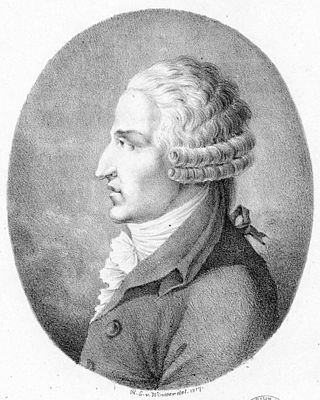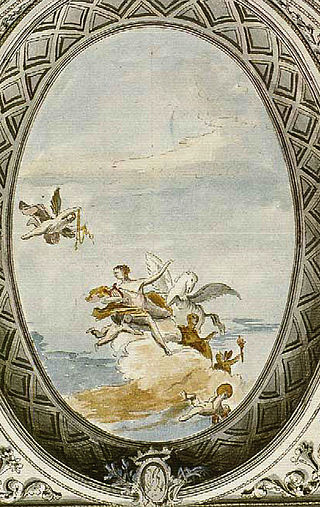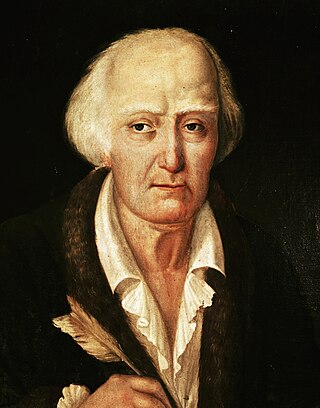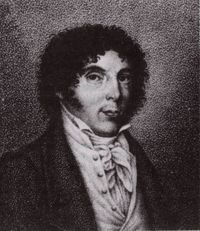Sources
- Warrack, John and West, Ewan (1992), The Oxford Dictionary of Opera, 782 pages, ISBN 0-19-869164-5
Giovanni Bertati (10 July 1735 – 1 March 1815) was an Italian librettist.
Bertati was born in Martellago, Italy. In 1763, he wrote his first libretto, La morte di Dimone ("The Death of Dimone"), set to music by Antonio Tozzi. Two years later, L'isola della fortuna ("The Island of Fortune"), based on Bertati's libretto and Andrea Luchesi's music, was performed in Vienna. During 1770, Bertati visited Vienna several times, where he collaborated with Baldassare Galuppi. Emperor Leopold II gave Bertati the title of Poeta Cesareo ("Imperial Poet") of the Italian Opera in Vienna, previously held by Lorenzo Da Ponte, who, a year earlier, fell in disgrace with the emperor. He died in Venice, Italy.
During his career as a librettist, Bertati was almost exclusively devoted to writing drammi giocosi. His most celebrated libretto is Il matrimonio segreto ("The Secret Marriage"), set to the music of Domenico Cimarosa, and premiered on 7 February 1792, in Vienna.
The following is the list of 70 libretti by Bertati; the years refer to first performances.
"Melinda" (1798)

Giuseppe Gazzaniga was a member of the Neapolitan school of opera composers. He composed fifty-one operas and is considered to be one of the last Italian opera buffa composers.

Pasquale Anfossi was an Italian opera composer. Born in Taggia, Liguria, he studied with Niccolò Piccinni and Antonio Sacchini, and worked mainly in London, Venice and Rome.
Vincenzo Fabrizi was an Italian composer of opera buffa.

Giuseppe Aprile was an Italian castrato singer and music teacher. He was also known as 'Sciroletto' or 'Scirolino'.
A catalogue aria is a genre of opera aria in which the singer recounts a list of information that was popular in Italian comic opera in the latter half of the eighteenth and early nineteenth centuries.

The Teatro San Moisè was a theatre and opera house in Venice, active from 1620 to 1818. It was in a prominent location near the Palazzo Giustinian and the church of San Moisè at the entrance to the Grand Canal.
Gennaro Astarita was an Italian composer, mainly of operas. The place of his birth is unknown, although he was active in Naples for many years. He began his operatic career in 1765, collaborating with Niccolò Piccinni in the writing of the opera L'orfana insidiata. He became the maestro di cappella in Naples in 1770.
Marcello Bernardini was an Italian composer and librettist. Little is known of him, save that he wrote 37 operas in his career. His father was most likely the composer Rinaldo di Capua.
Giovanni Battista Lorenzi was an Italian librettist. He was born in Puglia and died in Naples and was a friend of Giovanni Paisiello, with whom he collaborated on numerous operas.

Giacomo Domenico Mario Antonio Pasquale Giuseppe Tritto was an Italian composer, known primarily for his fifty-four operas. He was born in Altamura, and studied in Naples; among his teachers were Nicola Fago, Girolamo Abos, and Pasquale Cafaro. Amongst his pupils were the young Vincenzo Bellini around 1821, plus Ferdinando Orlandi. He died in Naples.
Antonio Palomba (20 December 1705 – 1769) was an Italian opera librettist, poet, harpsichordist, and music educator. He also worked as a notary. Born in Naples, he became a teacher of the harpsichord at the Teatro della Pace in 1749. Most of his more than 50 opera libretti were comedic works written for composers of the Neapolitan school. He also wrote some works for performance in Florence, Bologna and abroad. He died in Naples in 1769; one of the victims of a fever epidemic in the city. Many of his libretti were set more than once to music, and composers continued to use his libretti up into the 1830s.
Ferdinando Orlandi, also referred to as Orland and Orlando. Little is known of his early life and his year of birth is also cited as 1777. He was an Italian musician and teacher of singing who composed cantatas and sacred music, but was particularly known for his operas, not all of which have survived. He was born and died in Parma.

Stefano Pavesi was an Italian composer. He is primarily known as a prolific opera composer; his breakthrough opera was Fingallo e Comala, and his acknowledged opera masterpiece is Ser Marcantonio. He also served as the maestro di cappella of Crema Cathedral from 1814 to 1818, and alone from 1818 until his death at the age of 71.
La passione di Gesù Cristo is a libretto by Pietro Metastasio which was repeatedly set as an azione sacra or oratorio by many composers of the late baroque, Rococo and early classical period.

In music history, the Neapolitan School is a group, associated with opera, of 17th and 18th-century composers who studied or worked in Naples, Italy, the best known of whom is Alessandro Scarlatti, with whom "modern opera begins". Francesco Provenzale is generally considered the school's founder. Others significant composers of this school are Giambattista Pergolesi, Domenico Cimarosa and Giovanni Paisiello.
It is with the Neapolitan school...that the History of Modern Music commences—insofar as that music speaks the language of the feelings, emotions, and passions.

L'avaro, is an opera in three acts composed by Pasquale Anfossi. The libretto by Giovanni Bertati is based on Molière's 17th-century comedy The Miser. Considered one of Anfossi's best operas, it premiered at the Teatro San Moisè in Venice in the autumn season of 1775 and was subsequently performed throughout Italy and in other European cities.
Giovanni Ansani was an Italian tenor and composer.
Antonio Simeone Sografi, also known as Antonio Simon, or just Antonio, was an Italian librettist and playwright.
Giuseppe Maria Foppa was an Italian librettist. He wrote around 150 libretti, mainly for comic operas, as well as Latin oratorio texts and his memoirs. He composed work for theatres in Milan, Genoa, Pistoia, Padua, Reggio Emilia, Bologna, and Florence.
Ipermestra is an opera libretto by Pietro Metastasio first set by Johann Adolph Hasse 8 January 1744, and in the November of the same year by Christoff Willibald Gluck.